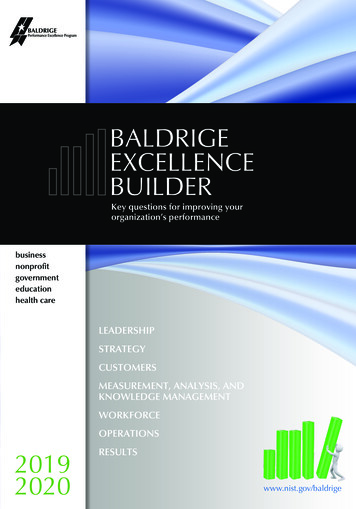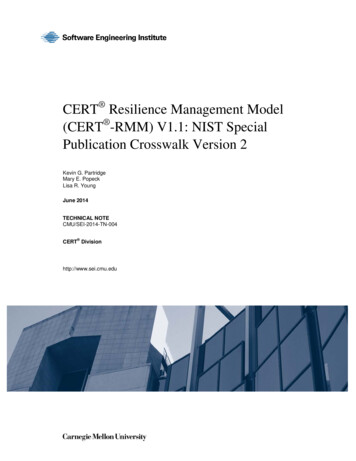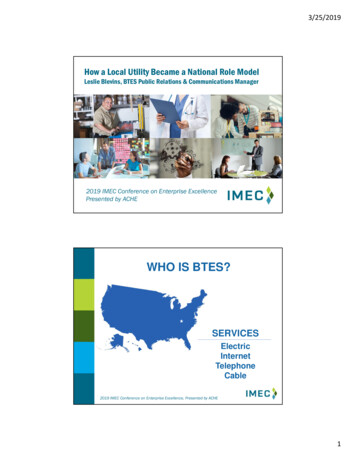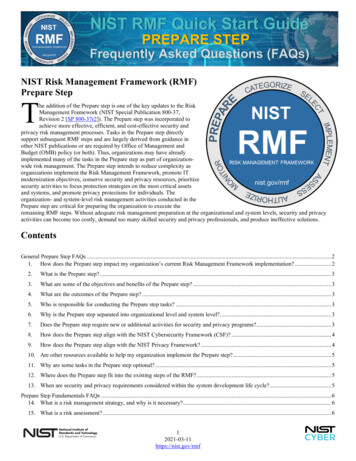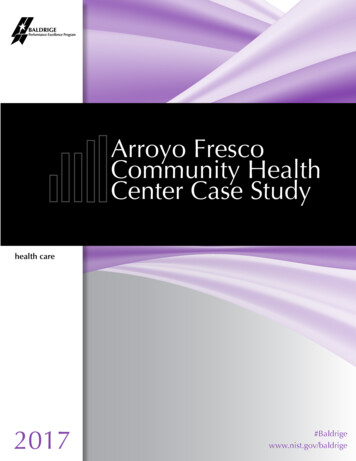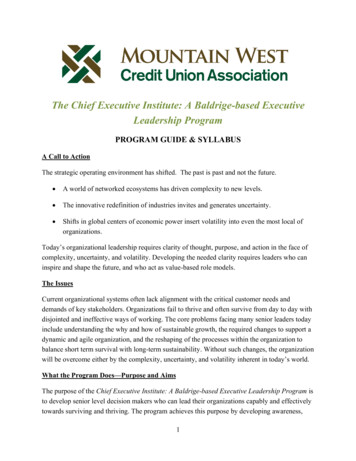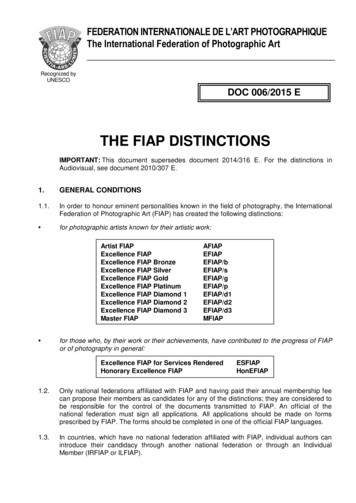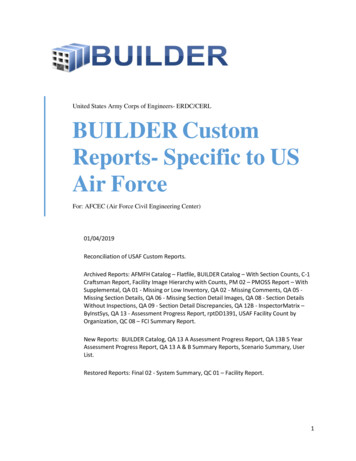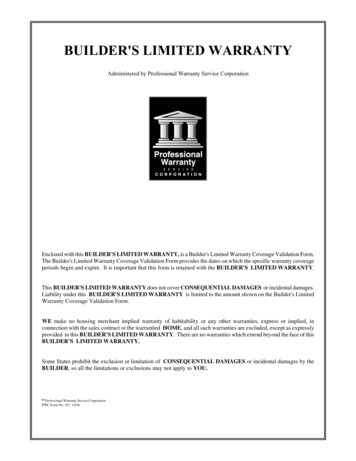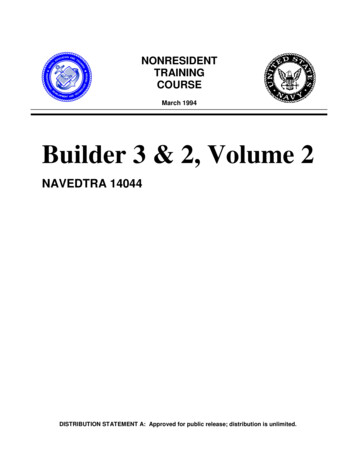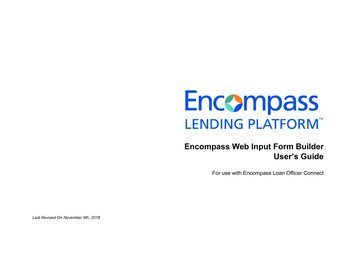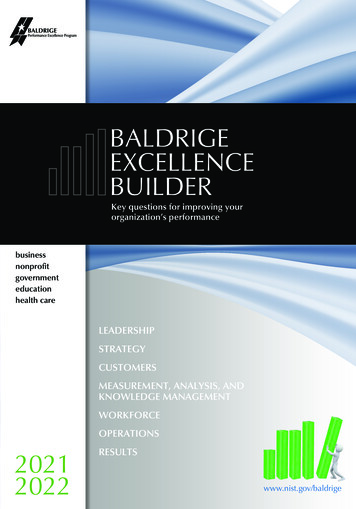
Transcription
BALDRIGEEXCELLENCEBUILDERKey questions for improving yourorganization’s lth careLEADERSHIPSTRATEGYCUSTOMERSMEASUREMENT, ANALYSIS, ANDKNOWLEDGE st.gov/baldrige
Improve Your PerformanceThe Baldrige Excellence Builder self-assessment helps you identify and improve what is criticalto your organization’s success. By completing and acting on this assessment, you will be betterpositioned to accomplish your mission, improve your results, and become more competitive.The Excellence Builder is based on the more detailed Baldrige Excellence Framework andits Criteria for Performance Excellence.Here’s what the Baldrige Excellence Framework can do for you.ManufacturerAchieved annual cost savings of 225 million through process andperformance improvementsCity GovernmentRated in top 10% of citiesnationally for best place tolive and work, culture andrecreation, and jobopportunitiesSmall BusinessIncreased total gross profit by13% over 3 years, 8.4 pointsbetter than the nationalbenchmarkOrganizational onCustomersOperationsMeasurement, Analysis, and Knowledge ManagementHospitalsCoreValues and ConceptSet national benchmarksfor patient safetyNonprofitAchieved customersatisfaction of 100%Community CollegeOutperformed local and national peersby more than 200% in growth rate forcompletion of associate degrees andcertificatesPurchase the Baldrige Excellence Framework Today!www.nist.gov/baldrige/publications
Contents2About the Baldrige Excellence BuilderThe Baldrige Excellence Builder represents proven leadership and managementpractices for high performance.4Core Values and ConceptsThese beliefs and behaviors found in high-performing organizations are the basis of theBaldrige Excellence Builder.5Baldrige Excellence BuilderAnswer these questions about the most important features of organizationalperformance excellence.14Assessing Your ResponsesAssess your answers to the Baldrige Excellence Builder questions.16Glossary of Key TermsLearn the defnitions of key terms in the Baldrige Excellence Builder.I have always envisioned Stellar to be a company that is builtto last. . . . And if you ask how we can ensure that we arebuilt to last, I would say the answer is Baldrige. . . . Unlikemany other certifcations or performance excellence measures,it is not prescriptive—it is adaptable to any organization, atany point on its journey to excellence.—Celeste Ford, Founder and CEO, Baldrige Award recipientStellar Solutions1
About the Baldrige Excellence BuilderIs your organization doing as well as it could? How do you know? What andhow should your organization improve or change?Whether your organization is new, is growing, or has existed for many years, it faces dailyand long-term challenges. It also has strengths that have served you well so far. The BaldrigeExcellence Builder helps you assess your organization’s strengths and opportunities forimprovement. By completing and acting on this assessment, you will be better positioned toaccomplish your mission, improve your results, and become more competitive.The Baldrige Excellence Builder is based on the more detailed Baldrige Excellence Frameworkand its Criteria for Performance Excellence (see www.nist.gov/baldrige/publications). For morethan 30 years, Baldrige has been globally recognized as the leading edge of validated leadership and performance practice. Baldrige is a nonprescriptive framework that empowers yourorganization to reach its goals, improve results, and become more competitive. The Core Valuesand Concepts (see page 4), a set of beliefs and behaviors found in high-performing organizations, are the foundation of this framework.A Focus on ImprovementThe Baldrige Excellence Builder helps you understand how well you are achieving your goalsand objectives: Are your processes consistently effective? Do your approaches address your organization’s needs? How good are your results? Is your organization learning, innovating, and improving?As you answer the Baldrige Excellence Builder questions and assess your responses, you willidentify strengths and opportunities for improvement. Then, as you build on your strengthsand address your opportunities, you create cycles of improvement within your organization.A Systems PerspectiveA systems perspective means managing all the parts of your organization as a unifed whole toachieve your mission. It means ensuring that your plans, processes, measures, and actions areconsistent. And it means ensuring that the individual parts of your organization’s managementsystem work together in a fully interconnected, unifed, and mutually benefcial manner.2Baldrige Excellence Builder
How to Use the Baldrige Excellence BuilderAnswer the Organizational Profle questions. The Baldrige Excellence Builder does notprescribe how you should structure your organization or its operations, or what its missionand goals should be. In the Organizational Profle (pages 5–6), you defne what is mostrelevant and important to your organization’s mission and performance.The Organizational Profle sets the context for your answers to the rest of the questions. Itcan also serve as your frst Baldrige self-assessment: if you identify topics for which you haveconficting, little, or no information, you can use those topics for action planning.Answer the questions in categories 1–7 (pages 7–13). Your answers to these questionsare an assessment against the most important features of organizational excellence. Thecategories represent seven critical aspects of managing and performing as an organization:(1) Leadership; (2) Strategy; (3) Customers; (4) Measurement, Analysis, and KnowledgeManagement; (5) Workforce; (6) Operations; and (7) Results.Categories 1–6 (pages 7–12) each consist of two items (e.g., 1.1, 1.2), with many of thequestions beginning with “how.” In answering these questions, give information on your keyprocesses: Approach: How do you accomplish your organization’s work? How systematic andeffective are your key approaches? Deployment: How consistently are your key approaches used in relevant parts ofyour organization? Learning: How well have you evaluated and improved your key approaches? Haveimprovements been shared within your organization? Has new knowledge led toinnovation? Integration: How well do your approaches refect your current and future organizational needs?For the fve items in category 7 (page 13), report on the results that are the most important toyour organization’s success: Levels: What is your current performance? Trends: Are the results improving, staying the same, or getting worse? Comparisons: How does your performance compare with that of other organizationsand competitors, or with benchmarks or industry leaders? Integration: Are you tracking results that are important to your organization? Are youusing the results in decision making?Assess your answers: process and results. Use the rubric on pages 14–15 to assess youranswers to the questions in each item. Identify your strengths. Then look at the next higherlevel to see what you might improve.Prioritize your actions. Celebrate your strengths and build on them to improve the thingsyou do well. Sharing the things you do well with the rest of your organization can speedimprovement. Also prioritize your opportunities for improvement; you cannot do everything atonce. Think about what is most important for your organization at this time, and decide whatto work on frst. Develop an action plan, implement it, and measure your progress.After you use the Baldrige Excellence Builder, please email us at baldrige@nist.gov to tell usabout your experience.About the Baldrige Excellence Builder3
Core Values and ConceptsThe Baldrige Excellence Framework and Baldrige Excellence Builder arebased on these core values and concepts.Systems perspective. A systems perspective means managing all the parts of your organization as a unifed whole to achieve your mission and strive toward your vision.Visionary leadership. Your organization’s senior leaders should set a vision for the organization, create a customer focus, demonstrate clear and visible organizational values and ethics,and set high expectations for the workforce.Customer-focused excellence. Your customers are the ultimate judges of your performanceand of product and service quality. Thus, your organization must consider all product andservice characteristics, and modes of customer access and support, that contribute to customersatisfaction, loyalty, positive referrals, and ultimately your organization’s ongoing success.Valuing people. A successful organization values its workforce members and the other peoplewho have a stake in the organization, including customers, community members, suppliersand partners, and other people affected by its actions.Agility and resilience. Agility requires a capacity for rapid change and for fexibility. Organizational resilience is the ability to anticipate, prepare for, and recover from disruptions, and toprotect and enhance workforce and customer engagement, organizational performance, andcommunity well-being when disruptions occur.Organizational learning. Organizational learning includes both continuous improvement ofexisting approaches and signifcant change or innovation, leading to new goals, approaches,products, and markets.Focus on success and innovation. Ensuring your organization’s success now and in thefuture requires understanding the short- and longer-term factors that affect your organizationand its environment. It also requires the ability to drive organizational innovation. Innovationmeans making meaningful change to improve your products, services, programs, processes,operations, and business model, with the purpose of creating new value for stakeholders.Management by fact. Management by fact requires you to measure and analyze yourorganization’s performance, both inside the organization and in your competitive environment. Analysis of performance should support organizational evaluation, alignment, anddecision making.Societal contributions. Your organization’s leaders should stress contributions to the publicand the consideration of societal well-being and beneft.Your leaders should be role modelsfor the well-being of your communities.Ethics and transparency. Your organization should stress ethical behavior by all workforcemembers in all stakeholder transactions and interactions. Senior leaders should be role modelsof ethical behavior, including transparency, characterized by candid and open communicationon the part of leadership and management and by the sharing of accurate information.Delivering value and results. Your organization should choose and analyze results that helpyou deliver and balance value for your key stakeholders. Thus, results need to include not justfnancial results, but also product and process results; customer and workforce satisfaction andengagement results; and leadership, strategy, and societal performance.4Baldrige Excellence Builder
Baldrige Excellence BuilderThe Baldrige Excellence Builder includes questions on the most importantfeatures of organizational excellence, starting with a full OrganizationalProfle. For a more comprehensive set of questions, see the Baldrige ExcellenceFramework booklet (Business/Nonproft, Education, or Health Care;www.nist.gov/baldrige/publications).P Organizational ProfileP.1 Organizational Description: What are your key organizationalcharacteristics?a. Organizational Environment(1) Product Offerings What are your main product offerings*? What is the relative importance of each to your success? What mechanisms do you use to deliver your products?(2) MISSION, VISION, VALUES, and Culture What are your MISSION, VISION, and VALUES?Other than VALUES, what are the characteristics of your organizational culture? What areyour organization’s CORE COMPETENCIES, and what is their relationship to your MISSION?(3) WORKFORCE Profile What is your WORKFORCE profle? What recent changes have youexperienced in WORKFORCE composition or in your needs with regard to your WORKFORCE?What are your WORKFORCE or employee groups and SEGMENTS; the educational requirements for different employee groups and SEGMENTS; the KEY drivers that engage them; your organized bargaining units (union representation), if any; and your special health and safety requirements, if any?(4) Assets What are your major facilities, equipment, technologies, and intellectual property?(5) Regulatory Environment What are your KEY applicable occupational health and safetyregulations; accreditation, certifcation, or registration requirements; industry standards; andenvironmental, fnancial, and product regulations?b. Organizational Relationships(1) Organizational Structure What are your organizational leadership structure andGOVERNANCE structure? What structures and mechanisms make up your organization’sLEADERSHIP SYSTEM? What are the reporting relationships among your GOVERNANCE board,SENIOR LEADERS, and parent organization, as appropriate?(Continued on the next page)*For health care organizations,“product offerings” are health care services.For education organizations,“product offerings” are educational programs and services.See www.nist.gov/baldrige/publications for Baldrige frameworks tailored to the health care and education sectors.Baldrige Excellence Builder5
(2) CUSTOMERS** and STAKEHOLDERS What are your KEY market SEGMENTS, CUSTOMERgroups, and STAKEHOLDER groups, as appropriate? What are their KEY requirements andexpectations for your products, CUSTOMER support services, and operations, including anydifferences among the groups?(3) Suppliers, PARTNERS, and COLLABORATORS What are your KEY types of suppliers,PARTNERS, and COLLABORATORS? What role do they play in producing and delivering yourKEY products and CUSTOMER support services, and in enhancing your competitiveness?What role do they play in contributing and implementing INNOVATIONS in your organization? What are your KEY supply-network requirements?P.2 Organizational Situation: What is your organization’sstrategic situation?a. Competitive Environment(1) Competitive Position What are your relative size and growth in your industry or themarkets you serve? How many and what types of competitors do you have?(2) Competitiveness Changes What KEY changes, if any, are affecting your competitivesituation, including changes that create opportunities for INNOVATION and collaboration, asappropriate?(3) Comparative Data What KEY sources of comparative and competitive data are availablefrom within your industry? What KEY sources of comparative data are available from outsideyour industry? What limitations, if any, affect your ability to obtain or use these data?b. Strategic ContextWhat are your KEY STRATEGIC CHALLENGES and ADVANTAGES?c. PERFORMANCE Improvement SystemWhat is your PERFORMANCE improvement system, including your PROCESSES for evaluation andimprovement of KEY organizational projects and PROCESSES?Terms in SMALL CAPS are defined in the Glossary of Key Terms (pages 16–18).**For health care organizations,“customers” are the users of your health care services (e.g., patients, families, insurers, andother third-party payors).For education organizations,“customers” are the users of your educational programs and services (e.g., students andparents).6Baldrige Excellence Builder
1 Leadership1.1 Senior Leadership: How do your senior leaders lead the organization?(1) HOW do SENIOR LEADERS set and DEPLOY your organization’s VISION and VALUES?(2) HOW do SENIOR LEADERS’ personal actions demonstrate their commitment to legal andETHICAL BEHAVIOR?(3) HOW do SENIOR LEADERS communicate with and engage the entire WORKFORCE, KEYPARTNERS, and KEY CUSTOMERS?(4) HOW do SENIOR LEADERS create an environment for success now and in the future?(5) HOW do SENIOR LEADERS create a focus on action that will achieve the organization’sMISSION?1.2 Governance and Societal Contributions: How do you govern yourorganization and make societal contributions?(1) HOW does your organization ensure responsible GOVERNANCE?(2) HOW do you evaluate the PERFORMANCE of your SENIOR LEADERS and your GOVERNANCEboard?(3) HOW do you address current and anticipate future legal, regulatory, and communityconcerns with your products and operations?(4) HOW do you promote and ensure ETHICAL BEHAVIOR in all interactions?(5) HOW do you incorporate societal well-being and beneft into your strategy and dailyoperations?(6) HOW do you actively support and strengthen your KEY communities?Terms in SMALL CAPS are defined in the Glossary of Key Terms (pages 16–18).Baldrige Excellence Builder7
2 Strategy2.1 Strategy Development: How do you develop your strategy?(1) HOW do you conduct your strategic planning?(2) HOW does your strategy development PROCESS stimulate and incorporate INNOVATION?(3) HOW do you collect and analyze relevant data and develop information for use in yourstrategic planning PROCESS?(4) HOW do you decide which KEY PROCESSES will be accomplished by your WORKFORCE andwhich by external suppliers, PARTNERS, and COLLABORATORS?(5) What are your organization’s KEY STRATEGIC OBJECTIVES and their most important relatedGOALS?(6) HOW do your STRATEGIC OBJECTIVES achieve appropriate balance among varying andpotentially competing organizational needs?2.2 Strategy Implementation: How do you implement your strategy?(1) What are your KEY short- and longer-term ACTION PLANS?(2) HOW do you DEPLOY your ACTION PLANS?(3) HOW do you ensure that fnancial and other resources are available to support theachievement of your ACTION PLANS while you meet current obligations?(4) What are your KEY WORKFORCE plans to support your short- and longer-term STRATEGICOBJECTIVES and ACTION PLANS?(5) What KEY PERFORMANCE MEASURES or INDICATORS do you use to track the achievementand EFFECTIVENESS of your ACTION PLANS?(6) For these KEY PERFORMANCE MEASURES or INDICATORS, what are your PERFORMANCEPROJECTIONS for your short- and longer-term planning horizons?(7) HOW do you recognize and respond when circumstances require a shift in ACTION PLANSand rapid execution of new plans?Terms in SMALL CAPS are defined in the Glossary of Key Terms (pages 16–18).8Baldrige Excellence Builder
3 Customers3.1 Customer Expectations: How do you listen to your customers anddetermine products and services to meet their needs?(1) HOW do you listen to, interact with, and observe CUSTOMERS* to obtain actionableinformation?(2) HOW do you listen to potential CUSTOMERS to obtain actionable information?(3) HOW do you determine your CUSTOMER groups and market SEGMENTS?(4) HOW do you determine product offerings?3.2 Customer Engagement: How do you build relationships withcustomers and determine satisfaction and engagement?(1) HOW do you build and manage CUSTOMER relationships?(2) HOW do you enable CUSTOMERS to seek information and support?(3) HOW do you manage CUSTOMER complaints?(4) HOW do your CUSTOMER experience PROCESSES ensure fair treatment for differentCUSTOMERS, CUSTOMER groups, and market SEGMENTS?(5) HOW do you determine CUSTOMER satisfaction, dissatisfaction, and ENGAGEMENT?(6) HOW do you obtain information on CUSTOMERS’ satisfaction with your organization relativeto other organizations?(7) HOW do you use VOICE-OF-THE-CUSTOMER and market data and information?Terms in SMALL CAPS are defined in the Glossary of Key Terms (pages 16–18).*For health care organizations, “customers” are the users of your health care services (e.g., patients, families, insurers, andother third-party payors).For education organizations, “customers” are the users of your educational programs and services (e.g., students andparents).Baldrige Excellence Builder9
4 Measurement, Analysis, andKnowledge Management4.1 Measurement, Analysis, and Improvement of OrganizationalPerformance: How do you measure, analyze, and thenimprove organizational performance?(1) HOW do you track data and information on daily operations and overall organizationalPERFORMANCE?(2) HOW do you select comparative data and information to support fact-based decisionmaking?(3) HOW do you ensure that your PERFORMANCE measurement system can respond to rapid orunexpected organizational or external changes and provide timely data?(4) HOW do you review your organization’s PERFORMANCE and capabilities?(5) HOW do you project your organization’s future PERFORMANCE?(6) HOW do you use fndings from PERFORMANCE reviews to develop priorities for continuousimprovement and opportunities for INNOVATION?4.2 Information and Knowledge Management: How do you manage yourinformation and your organizational knowledge assets?(1) HOW do you verify and ensure the quality of organizational data and information?(2) HOW do you ensure the availability of organizational data and information?(3) HOW do you build and manage organizational knowledge?(4) HOW do you share best practices in your organization?(5) HOW do you use your knowledge and resources to embed LEARNING in the way yourorganization operates?Terms in SMALL CAPS are defined in the Glossary of Key Terms (pages 16–18).10Baldrige Excellence Builder
5 Workforce5.1 Workforce Environment: How do you build an effective andsupportive workforce environment?(1) HOW do you assess your WORKFORCE CAPABILITY and CAPACITY needs?(2) HOW do you recruit, hire, and onboard new WORKFORCE members?(3) HOW do you prepare your WORKFORCE for changing CAPABILITY and CAPACITY needs?(4) HOW do you organize and manage your WORKFORCE?(5) HOW do you ensure workplace health, security, and accessibility for the WORKFORCE?(6) HOW do you support your WORKFORCE via services, benefts, and policies?5.2 Workforce Engagement: How do you engage your workforce forretention and high performance?(1) HOW do you determine the KEY drivers of WORKFORCE ENGAGEMENT?(2) HOW do you assess WORKFORCE ENGAGEMENT?(3) HOW do you foster an organizational culture that is characterized by open communication,HIGH PERFORMANCE, and an engaged WORKFORCE?(4) HOW does your WORKFORCE PERFORMANCE management system support HIGHPERFORMANCE?(5) HOW does your LEARNING and development system support the personal development ofyour WORKFORCE members and your organization’s needs?(6) HOW do you evaluate the EFFECTIVENESS of your LEARNING and development system?(7) HOW do you manage career development for your WORKFORCE and your future leaders?(8) HOW do you ensure that your PERFORMANCE management, PERFORMANCE development,and career development PROCESSES promote equity and inclusion for a diverse WORKFORCEand different WORKFORCE groups and SEGMENTS?Terms in SMALL CAPS are defined in the Glossary of Key Terms (pages 16–18).Baldrige Excellence Builder11
6 Operations6.1 Work Processes: How do you design, manage, and improveyour key products and work processes?(1) HOW do you determine KEY product* and WORK PROCESS requirements?(2) What are your organization’s KEY WORK PROCESSES?(3) HOW do you design your products and WORK PROCESSES to meet requirements?(4) HOW does your day-to-day operation of WORK PROCESSES ensure that they meet KEYPROCESS requirements?(5) HOW do you determine your KEY support PROCESSES?(6) HOW do you improve your WORK PROCESSES and support PROCESSES to improve productsand PROCESS PERFORMANCE, enhance your CORE COMPETENCIES, and reduce variability?(7) HOW do you manage your supply network?(8) HOW do you pursue your identifed opportunities for INNOVATION?6.2 Operational Effectiveness: How do you ensureeffective management of your operations?(1) HOW do you manage the cost, effciency, and EFFECTIVENESS of your operations?(2) HOW do you ensure the security and cybersecurity of sensitive or privileged dataand information and of KEY assets?(3) HOW do you provide a safe operating environment for your WORKFORCE and other peoplein your workplace?(4) HOW do you ensure that your organization can anticipate, prepare for, and recover fromdisasters, emergencies, and other disruptions?Terms in SMALL CAPS are defined in the Glossary of Key Terms (pages 16–18).*For health care organizations, “products” are health care services.For education organizations, “products” are educational programs and services.See www.nist.gov/baldrige/publications for Baldrige frameworks tailored to the health care and education sectors.12Baldrige Excellence Builder
7 Results7.1 Product and Process Results: What are your productperformance and process effectiveness results?(1) What are your RESULTS for your products and your CUSTOMER service PROCESSES?(2) What are your PROCESS EFFECTIVENESS and effciency RESULTS?(3) What are your safety and emergency preparedness RESULTS?(4) What are your supply-network management RESULTS?7.2 Customer Results: What are your customer-focusedperformance results?(1) What are your CUSTOMER satisfaction and dissatisfaction RESULTS?(2) What are your CUSTOMER ENGAGEMENT RESULTS?7.3 Workforce Results: What are your workforce-focusedperformance results?(1) What are your WORKFORCE CAPABILITY and CAPACITY RESULTS?(2) What are your workplace climate RESULTS?(3) What are your WORKFORCE ENGAGEMENT RESULTS?(4) What are your WORKFORCE and leader development RESULTS?7.4 Leadership and Governance Results: What are yoursenior leadership and governance results?(1) What are your RESULTS for SENIOR LEADERS’ communication and engagement with theWORKFORCE, PARTNERS, and CUSTOMERS?(2) What are your RESULTS for GOVERNANCE accountability?(3) What are your legal and regulatory RESULTS?(4) What are your RESULTS for ETHICAL BEHAVIOR?(5) What are your RESULTS for societal well-being and support of your KEY communities?7.5 Financial, Market, and Strategy Results: What are yourresults for financial viability and strategy implementation?(1) What are your fnancial PERFORMANCE RESULTS?(2) What are your marketplace PERFORMANCE RESULTS?(3) What are your RESULTS for achievement of your organizational strategy and ACTION PLANS?Terms in SMALL CAPS are defined in the Glossary of Key Terms (pages 16–18).Baldrige Excellence Builder13
Assessing Your ResponsesFor scoring guidelines, see the Baldrige Excellence Framework booklet(Business/Nonproft, Education, or Health Care; www.nist.gov/baldrige/publications).Assessing ProcessesProcesses are the methods your organization uses and improves to do its work. The fourfactors used to evaluate processes are approach, deployment, learning, and integration (seepage 3).For process items (those in categories 1–6), read the process scoring rubric on page 15. Foreach item, assign one of the descriptors (Reactive, Early, Mature, or Role Model) based on aholistic assessment of your processes.Assessing ResultsResults are the outputs and outcomes your organization achieves. The four factors used toevaluate results are levels, trends, comparisons, and integration (see page 3).For results items (7.1–7.5), read the results scoring rubric on page 15. For each item, assign oneof the descriptors based on a holistic assessment of your overall performance.14Baldrige Excellence Builder
Assessing Your Responses15Role ModelMatureEarlyReactiveDESCRIPTORStrategicand OperationalGoalsStrategicand OperationalGoalsStrategic andOperationalGoalsStrategicand OperationalGoals The full array of resultsthat are important to theorganization’s ongoingsuccess are reportedand trended over time,indicating top performancerelative to otherorganizations. Results that are importantto the organization’songoing success aretrending in the rightdirection and doing wellrelative to competitorsor other relevantorganizations. Operations are characterized by repeatableprocesses that are regularly evaluated forimprovement. Learnings are shared, and thereis coordination among organizational units.Processes address key strategies and goals. Operations are characterized by repeatableprocesses that are regularly evaluated forchange and improvement in collaborationwith other affected units. The organizationseeks and achieves effciencies across unitsthrough analysis, innovation, and the sharingof information and knowledge. Processes andmeasures track progress on key strategic andoperational goals. Results that are importantto the organization’songoing success arereported, tracked overtime, and improving. Results that are importantto the organization’songoing success aremissing, not used, orrandomly reported.RESULTS The organization is beginning to carryout operations with repeatable processes,evaluation, and improvement, and there issome early coordination among organizationalunits. Strategy and quantitative goals are beingdefned. Operations are characterized by activitiesrather than by processes, and they are largelyresponsive to immediate needs or problems.Goals are poorly defned.PROCESS
Glossary of Key TermsThe terms below are those in SMALL CAPS in the Baldrige Excellence Builder,as well as terms relating to the scoring rubric. For additional defnitions andexamples, see the Baldrige Excellence Framework booklet (Business/Nonproft,Education, or Health Care; www.nist.gov/baldrige/publications).ACTION PLANS. Specifc actions that yourorganization takes to reach its strategic objectives. These plans specify the resources committed to and the time horizons for accomplishingthe plans. See also STRATEGIC OBJECTIVES.ALIGNMENT. A state of consistency amongplans, processes, information, resourcedecisions, workforce capability and capacity,actions, results, and analyses that support keyorganization-wide goals. See also INTEGRATION.APPROACH. The methods your organizationuses to carry out its processes.COLLABORATORS. Organizations or individuals who cooperate with your organization tosupport a particular activity or event or whocooperate intermittently when their short-termgoals are aligned with or are the same as yours.See also PARTNERS.CORE COMPETENCIES. Your organization’sareas of greatest expertise; those strategicallyimpo
built to last, I would say the answer is Baldrige. . . . Unlike many other certifcations or performance excellence measures, . Ensuring your organization’s success now and in the future requires understanding the sho
